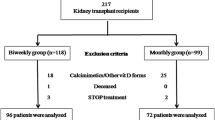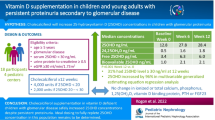Abstract
Vitamin D deficiency is frequent in pediatric nephrology. The 2017 European guidelines recommend keeping 25OH vitamin D (25-D) levels within the 75–120 nmol/L range, ideally with daily supplementation. Intermittent supplementation with D3 has also been proposed. We aimed to assess the influence of our local protocol of intermittent vitamin D supplementation on the evolution of 25-D levels between baseline and 2 months. VITATOL is a prospective single-center study performed in our tertiary unit in children and teenagers followed for chronic kidney disease (CKD), kidney transplantation, or stable chronic nephrotic syndrome with 25-D levels below 75 nmol/L. Intermittent oral cholecalciferol (100,000 IU) was administered depending on baseline vitamin D levels and body weight. The primary outcome was the change in 25-D levels between baseline and 2 months. Secondary outcomes were the evolution of the main mineral biomarkers. Thirty-seven patients were included. Two months after beginning supplementation, corresponding to a median(min-max) of 46 (14–79) days after the last dose of vitamin D, 25-D levels increased from 50 to 76 nmol/L (p < 0.001), 18 patients having 25-D levels within the target range and 2 above. All patients displayed 25-D levels above 50 nmol/L. There were no significant changes in phosphate, PTH, alkaline phosphatase, and FGF23 levels before and after supplementation. Calcium levels increased from 2.39 to 2.44 mmol/L (p = 0.017), but no differences in calciuria and urinary calcium/creatinine ratio were observed.
Conclusion: This vitamin D supplementation protocol using intermittent moderate doses of cholecalciferol seems efficient in 54% of cases, with neither significant overdose nor hypercalciuria.
What is Known: • Vitamin D deficiency is frequent in pediatric nephrology. • The 2017 European guidelines recommend keeping 25OH vitamin D levels within the 75–120 nmol/L range ideally with daily supplementation, but intermittent supplementation with D3 has also been proposed. What is New: • We assessed the influence of a local protocol of intermittent vitamin D supplementation on the evolution of 25-D levels between baseline and 2 months in children and teenagers followed in pediatric nephrology. • The intermittent cholecalciferol supplementation protocol seems efficient in 54% of cases, with neither significant overdose nor hypercalciuria. |
Similar content being viewed by others
Abbreviations
- ALP:
-
Alkaline phosphatase
- UCa/creat:
-
Urinary calcium/creatinine ratio
- CKD:
-
Chronic kidney disease
- eGFR:
-
Estimated glomerular filtration rate
- ESPN:
-
European Society of Pediatric Nephrology
- FGF23:
-
Fibroblast growth factor 23
- IRB:
-
Institutional Review Board
- IU:
-
International unit
- KDIGO:
-
Kidney disease improving global outcomes
- KDOQI:
-
Kidney disease outcomes quality
- PTH:
-
Parathormone
- RCTs:
-
Randomized clinical trials
- SDS:
-
Standard deviation scores
- 25-D:
-
25hydroxy vitamin D
- 1-25-D:
-
1-25 di-hydroxy vitamin D
References
Bacchetta J, Ranchin B, Dubourg L, Cochat P (2010) Vitamin D revisited: a cornerstone of health? Arch Pediatr 17:1687–1695
Menon S, Valentini RP, Hidalgo G, Peschansky L, Mattoo TK (2008) Vitamin D insufficiency and hyperparathyroidism in children with chronic kidney disease. Pediatr Nephrol 23:1831–1836
Belostotsky V, Mughal MZ, Berry JL, Webb NJA (2008) Vitamin D deficiency in children with renal disease. Arch Dis Child 93:959–962
Bacchetta J, Chun RF, Gales B, Zaritsky JJ, Leroy S, Wesseling-Perry K, Boregaard N, Rastogi A, Salusky IB, Hewison M (2014) Antibacterial responses by peritoneal macrophages are enhanced following vitamin D supplementation. PLoS One 9:e116530. https://doi.org/10.1371/journal.pone.0116530
Adams JS, Hewison M (2010) Update in vitamin D. J Clin Endocrinol Metab 95:471–478
Li YC, Kong J, Wei M, Chen ZF, Liu SQ, Cao LP (2002) 1,25-Dihydroxyvitamin D3 is a negative endocrine regulator of the renin-angiotensin system. J Clin Invest 110:229–238
Bacchetta J, Pelletier S (2018) Vitamin D deficiency is associated with mortality in maintenance dialysis: moving forward from epidemiology to clinical trials. Nephrol Dial Transplant 33:1679–1682
KDOQI Work Group (2009) KDOQI clinical practice guideline for nutrition in children with CKD: 2008 update. Executive summary Am J Kidney Dis 53:S11–S104
Ketteler M, Block GA, Evenepoel P, Fukagawa M, Herzog CA, McCann L, Moe SM, Shroff R, Tonelli MA, Toussaint ND, Vervloet MG, Leonard MB (2018) Diagnosis, evaluation, prevention, and treatment of chronic kidney disease-mineral and bone disorder: synopsis of the kidney disease: improving global outcomes 2017 clinical practice guideline update. Ann Intern Med 168:422–430
Shroff R, Wan M, Nagler EV, Bakkaloglu S, Cozzolino M, Bacchetta J, Edefonti A, Stefanidis CJ, Vande Walle J, Ariceta G, Klaus G, Haffner D, Schmitt CP ; European Society for Paediatric Nephrology Chronic Kidney Disease Mineral and Bone Disorders and Dialysis Working Groups (2017) Clinical practice recommendations for treatment with active vitamin D analogues in children with chronic kidney disease stages 2-5 and on dialysis. Nephrol Dial Transplant 32:1114–1127
Shroff R, Wan M, Nagler EV, Bakkaloğlu S, Fischer D-C, Bishop N, Cozzolino M, Bacchetta J, Edefonti A, Stefanidis CJ, Vande Walle J, Haffner D, Klaus G, Schmitt CP ; European Society for Paediatric Nephrology Chronic Kidney Disease Mineral and Bone Disorders and Dialysis Working Groups (2017) Clinical practice recommendations for native vitamin D therapy in children with chronic kidney disease stages 2–5 and on dialysis. Nephrol Dial Transplant 32:1098–1113
Daroux M, Shenouda M, Bacri J-L, Lemaitre V, Vanhille P, Bataille P (2013) Vitamin D2 versus vitamin D3 supplementation in hemodialysis patients: a comparative pilot study. J Nephrol 26:152–157
Tripkovic L, Lambert H, Hart K, Smith CP, Bucca G, Penson S, Chope G, Hyppönen E, Berry J, Vieth R, Lanham-New S (2012) Comparison of vitamin D2 and vitamin D3 supplementation in raising serum 25-hydroxyvitamin D status: a systematic review and meta-analysis. Am J Clin Nutr 95:1357–1364
Courbebaisse M, Thervet E, Souberbielle JC, Zuber J, Eladari D, Martinez F, Mamzer-Bruneel MF, Urena P, Legendre C, Friedlander G, Prié D (2009) Effects of vitamin D supplementation on the calcium-phosphate balance in renal transplant patients. Kidney Int 75:646–651
Benaboud S, Urien S, Thervet E, Prié D, Legendre C, Souberbielle JC, Hirt D, Friedlander G, Treluyer JM, Courbebaisse M (2013) Determination of optimal cholecalciferol treatment in renal transplant recipients using a population pharmacokinetic approach. Eur J Clin Pharmacol 69:499–506
Vidailhet M, Mallet E, Bocquet A, Bresson J-L, Briend A, Chouraqui J-P, Darmaun D, Dupont C, Frelut ML, Ghisolfi J, Girardet JP, Goulet O, Hankard R, Rieu D, Simeoni U, Turck D; Comité de nutrition de la Société française de pédiatrie (2012) Vitamin D: still a topical matter in children and adolescents. A position paper by the Committee on Nutrition of the French Society of Paediatrics. Arch Pediatr 19:316–328
Sempé M, Pédron G, Roy-Pernot M.P. (1997) Auxologie méthode et séquences, 2nd edn. Méditions, Paris
Matos V, van Melle G, Boulat O, Markert M, Bachmann C, Guignard JP (1997) Urinary phosphate/creatinine, calcium/creatinine, and magnesium/creatinine ratios in a healthy pediatric population. J Pediatr 131:252–257
Schwartz GJ, Work DF (2009) Measurement and estimation of GFR in children and adolescents. Clin J Am Soc Nephrol 4:1832–1843
Armas LAG, Hollis BW, Heaney RP (2004) Vitamin D2 is much less effective than vitamin D3 in humans. J Clin Endocrinol Metab 89:5387–5391
Lal BB, Alam S, Khanna R, Rawat D (2018) Weekly regimen of vitamin D supplementation is more efficacious than stoss regimen for treatment of vitamin D deficiency in children with chronic liver diseases. Eur J Pediatr 177:827–834
Shroff R, Wan M, Gullett A, Ledermann S, Shute R, Knott C, Wells D, Aitkenhead H, Manickavasagar B, van’t Hoff W, Rees L (2012) Ergocalciferol supplementation in children with CKD delays the onset of secondary hyperparathyroidism: a randomized trial. Clin J Am Soc Nephrol 7:216–223
Westerberg P-A, Sterner G, Ljunggren Ö, Isaksson E, Elvarson F, Dezfoolian H, Linde T (2018) High doses of cholecalciferol alleviate the progression of hyperparathyroidism in patients with CKD stages 3–4: results of a 12-week double-blind, randomized, controlled study. Nephrol Dial Transplant 33:466–471
Yadav AK, Kumar V, Kumar V, Banerjee D, Gupta KL, Jha V (2018) The effect of vitamin D supplementation on bone metabolic markers in chronic kidney disease. J Bone Miner Res 33:404–409
Lerch C, Shroff R, Wan M, Rees L, Aitkenhead H, Kaplan Bulut I, Thurn D, Karabay Bayazit A, Niemirska A, Canpolat N, Duzova A, Azukaitis K, Yilmaz E, Yalcinkaya F, Harambat J, Kiyak A, Alpay H, Habbig S, Zaloszyc A, Soylemezoglu O, Candan C, Rosales A, Melk A, Querfeld U, Leifheit-Nestler M, Sander A, Schaefer F, Haffner D ; 4C study consortium; ESPN CKD-MBD working group (2018) Effects of nutritional vitamin D supplementation on markers of bone and mineral metabolism in children with chronic kidney disease. Nephrol Dial Transplant. 33:2208–2217
Mitsnefes MM (2012) Cardiovascular disease in children with chronic kidney disease. J Am Soc Nephrol 23:578–585
Jammal Addin MB, Young D, McCarrison S, Hunter L (2019) Dilated cardiomyopathy in a national paediatric population. Eur J Pediatr 178:1229–1235
Basatemur E, Hunter R, Horsfall L, Sutcliffe A, Rait G (2017) Costs of vitamin D testing and prescribing among children in primary care. Eur J Pediatr 176:1405–1409
Theodoratou E, Tzoulaki I, Zgaga L, Ioannidis JPA (2014) Vitamin D and multiple health outcomes: umbrella review of systematic reviews and meta-analyses of observational studies and randomised trials. BMJ. 348:g2035
Acknowledgements
The authors would like to thank patients and their families for accepting to be part of the VITATOL study. They also would like to acknowledge Mrs. Tiphanie Ginhoux, project manager in EPICIME, for her technical help with the administrative duties, and Dr. Marie-Christine Carlier (PharmD, Hospices Civils de Lyon) for her help in biochemical assessment.
Funding
This study was supported by the Crinex laboratories, with a research grant of 3000 euros for biochemical markers assessment and the centralized delivery of cholecalciferol doses.
Author information
Authors and Affiliations
Contributions
MA analyzed data and wrote the first draft of the manuscript.
OB, BR, ALSL, and ABT included patients and revised the manuscript.
BKK was involved in the study design and revised the manuscript.
JB designed the study, included patients, analyzed date and revised the manuscript.
Corresponding author
Ethics declarations
Conflict of interest
This study was supported by the Crinex laboratories, with a research grant for biochemical markers assessment and the centralized delivery of cholecalciferol doses. The Crinex laboratories were not involved neither in the design and conduct of the study nor in data analysis.
Ethical approval
VITATOL was approved by the local IRB (Comité de Protection des Personnes Lyon Sud Est IV, session A13–329).
Informed consent
Informed consent was obtained from all individual participants included in the study.
Additional information
Communicated by Mario Bianchetti
Publisher’s note
Springer Nature remains neutral with regard to jurisdictional claims in published maps and institutional affiliations.
Rights and permissions
About this article
Cite this article
Aurelle, M., Basmaison, O., Ranchin, B. et al. Intermittent cholecalciferol supplementation in children and teenagers followed in pediatric nephrology: data from a prospective single-center single-arm open trial. Eur J Pediatr 179, 661–669 (2020). https://doi.org/10.1007/s00431-019-03553-y
Received:
Revised:
Accepted:
Published:
Issue Date:
DOI: https://doi.org/10.1007/s00431-019-03553-y




